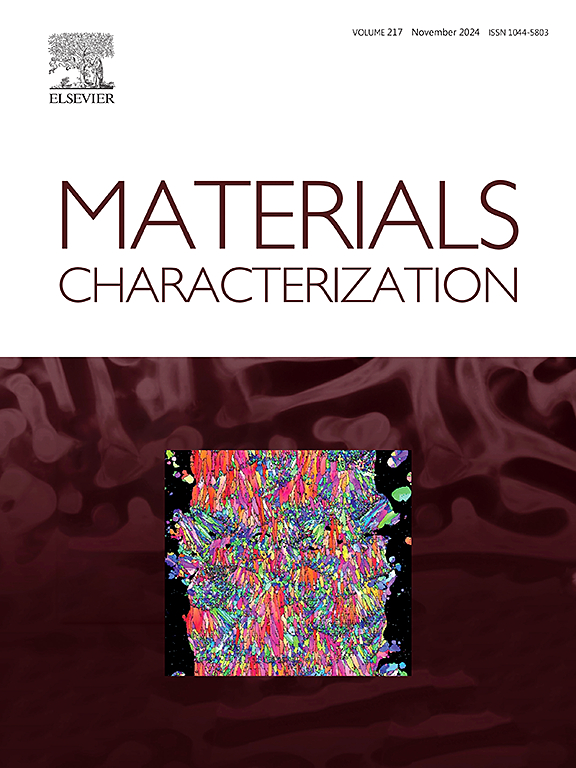铝基板上结构坚固且可粘合的铜涂层的固态增材制造
IF 4.8
2区 材料科学
Q1 MATERIALS SCIENCE, CHARACTERIZATION & TESTING
引用次数: 0
摘要
本研究提出了一种固态增材制造策略,用于使用冷喷涂增材制造(CSAM)工艺在铝(Al)衬底上制造高密度导电铜(Cu)涂层。随着入口气体温度和压力的增加,涂层密度、电导率和热传导率以及界面结合强度显著增强,这是由于更有效的塑性变形和由此产生的动态再结晶。通过将进气温度和压力分别优化到1000°C和50 bar,成功地获得了性能接近大块铜的Cu镀层,包括98% IACS的电导率和384 W·m−1·K−1的导热系数。同时,无需进行沉积后热处理即可获得超过50 MPa的界面结合强度。显微组织分析表明,升高的入口气体条件促进了Cu涂层内的动态再结晶,并通过形成金属间化合物促进了与Al基体的扩散结合。此外,来自沉积过程的局部热输入诱导Al衬底内部的部分恢复,导致化学和机械稳定的CuAl界面具有最小的残余应力。这些发现表明,CSAM工艺能够在喷射状态下在Al上沉积坚固的块状Cu层,提供了一种可扩展的、经济有效的、几何上通用的替代传统包层技术。该研究解决了CuAl连接的关键挑战,为Cu涂层在高性能、轻质结构和电气元件中的广泛应用铺平了道路。本文章由计算机程序翻译,如有差异,请以英文原文为准。
Solid-state additive manufacturing of structurally robust and bondable copper coatings on aluminum substrates
This study presents a solid-state additive manufacturing strategy for fabricating high-density, electrically conductive copper (Cu) coatings on aluminum (Al) substrates using the cold spray additive manufacturing (CSAM) process. Significant enhancements in coating density, electrical and thermal conductivities, and interfacial bonding strength were observed with increasing inlet gas temperature and pressure, attributable to more effective plastic deformation and resultant dynamic recrystallization. By optimizing the inlet gas temperature and pressure to 1000 °C and 50 bar, respectively, Cu deposits with properties approaching those of bulk Cu—including an electrical conductivity of 98 % IACS and a thermal conductivity of 384 W·m−1·K−1—were successfully achieved. Simultaneously, interfacial bonding strengths exceeding 50 MPa were achieved without the need for post-deposition heat treatments. Microstructural analyses revealed that elevated inlet gas conditions promoted dynamic recrystallization within the Cu coatings and facilitated diffusion bonding with the Al substrate through the formation of intermetallic compounds. Furthermore, localized thermal input from the deposition process induced partial recovery within the Al substrate, resulting in a chemically and mechanically stable Cu![]() Al interface with minimal residual stress. These findings demonstrate that the CSAM process enables the deposition of robust, bulk-like Cu layers on Al in the as-sprayed state, offering a scalable, cost-effective, and geometrically versatile alternative to conventional cladding techniques. This study addresses key challenges in Cu
Al interface with minimal residual stress. These findings demonstrate that the CSAM process enables the deposition of robust, bulk-like Cu layers on Al in the as-sprayed state, offering a scalable, cost-effective, and geometrically versatile alternative to conventional cladding techniques. This study addresses key challenges in Cu![]() Al joining and paves the way for the broader application of Cu coatings in high-performance, lightweight structural and electrical components.
Al joining and paves the way for the broader application of Cu coatings in high-performance, lightweight structural and electrical components.
求助全文
通过发布文献求助,成功后即可免费获取论文全文。
去求助
来源期刊

Materials Characterization
工程技术-材料科学:表征与测试
CiteScore
7.60
自引率
8.50%
发文量
746
审稿时长
36 days
期刊介绍:
Materials Characterization features original articles and state-of-the-art reviews on theoretical and practical aspects of the structure and behaviour of materials.
The Journal focuses on all characterization techniques, including all forms of microscopy (light, electron, acoustic, etc.,) and analysis (especially microanalysis and surface analytical techniques). Developments in both this wide range of techniques and their application to the quantification of the microstructure of materials are essential facets of the Journal.
The Journal provides the Materials Scientist/Engineer with up-to-date information on many types of materials with an underlying theme of explaining the behavior of materials using novel approaches. Materials covered by the journal include:
Metals & Alloys
Ceramics
Nanomaterials
Biomedical materials
Optical materials
Composites
Natural Materials.
 求助内容:
求助内容: 应助结果提醒方式:
应助结果提醒方式:


